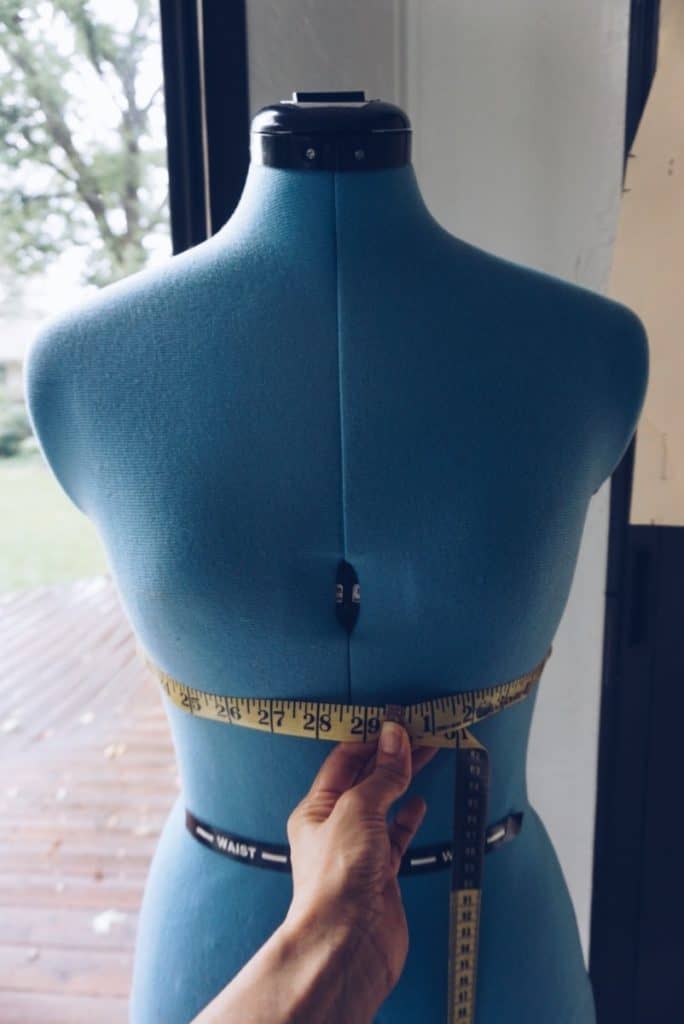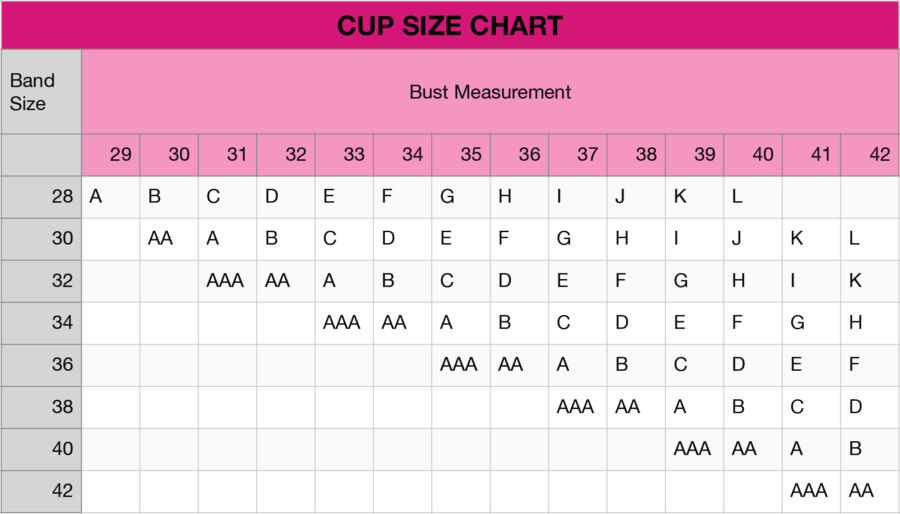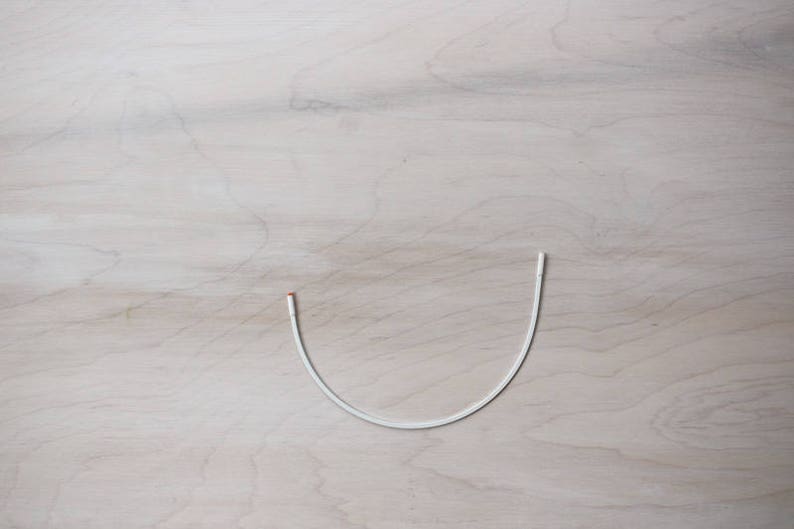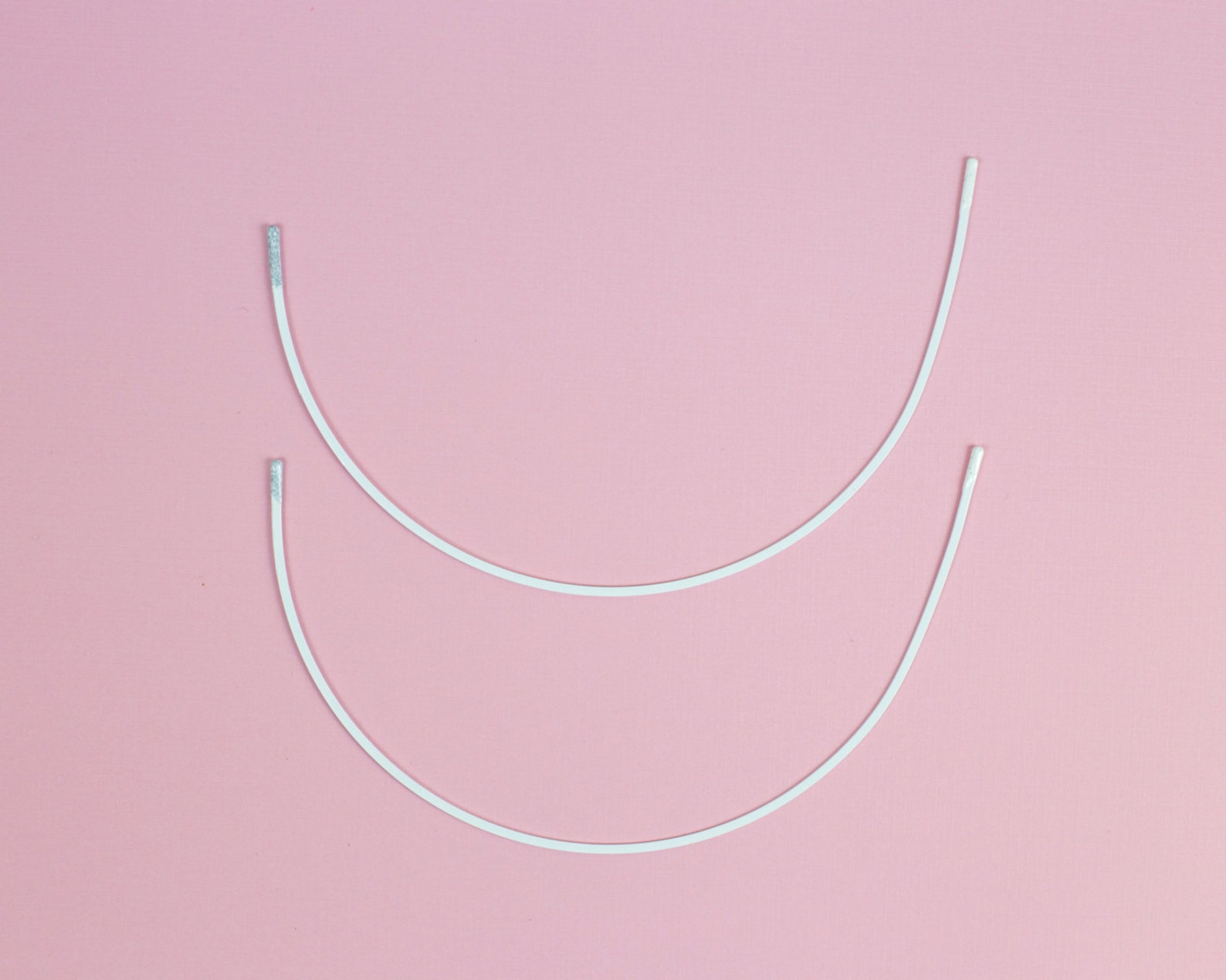Whether you are sewing an underwire bra or a swimsuit that requires an underwire it is important that you know your underwire size. Before you even purchase underwire be sure to measure for your correct bra size. Use my DIY Bra Measurements Guide to determine your correct bra size. Once you have your correct measurements then determining your underwire size will be a breeze!
This post contains affiliate links. When you click and make a purchase from these links, we might get a commission. It doesn’t cost you anything extra!
How to determine your underwire size?
In a nutshell, underwire size is based on your cup size and band size. See my chart below if you know your bra size (i.e. 34B). Your band size is the measurement around the perimeter of your torso just under your bust plus your chest measurement then divided by two. To determine your cup measurement subtract your band measurement from your bust measurement (this is the measurement around the widest point of your bust). Use the underwire chart below to determine your size. Where your band size and cup size intersect is your underwire measurement.
For more detail, you can use one of two techniques in my DIY Bra Measurements Guide to determine these two sizes.
Underwire Size Chart
Once you determine your correct cup size and band size you can use this handy chart to determine what your underwire size is:

What is an underwire?
A bra underwire is a half circle shape that is made out of steel gauge wire. It comes in a variety of shapes and sizes depending on the type of bra it is supporting. For example, a plunge bra requires a special underwire that does not extend between the bridge of the bra since the idea is to show more cleavage.
What is the purpose of an underwire?
Underwires are added to bras to create a more structured appearance. They typically offer more support and lift than a soft cup bra although new advances in bra design have made strides in supportive soft cup bras. Nonetheless, underwires create support by distributing the weight of the breast tissue and holding that tissue in place to create an appealing yet natural shape.
How does sizing work?
As we discussed earlier, sizing is determined based on a combination of your cup size and band size. When looking for your size on an underwire chart you will notice that the B cup size is used as the standard marker to move up or down a size. This means that if you are a B cup no matter your band size your underwire size will be the same as your band size. For example, if you are a 32B then your underwire will be a size 32. If you are a 32C then your underwire size is 34 because you moved up a cup size. If you are a 32A then your underwire size will be 30.
Measuring for your correct Bra size to Find your Underwire Size:
Always refer to your bra patterns size guide first before purchasing any items. The designer may have a prefered method of measurement for their specific pattern. Otherwise, try either of these two methods for measuring:
How to Take Your Band Measurement
Technique 1:
The band component is connected to the frame of the bra and wraps around the body then fastens in the back. The band is sometimes referred to as the “wings”.
Step 1: To measure the band make sure you are wearing an unpadded bra or are bra less. Your bra band sits just under your bust. This would be considered your torso.
Step 2: Head over to your mirror
Step 3: Standing straight but comfortably, take your measuring tape and measure around the perimeter of your torso just under your bust.

Step 4: Expel any air that is in your lungs. Because your band expands with your lungs you want to make sure you measure at your smallest circumference aka when your lungs are no longer expanded after you release a full breath.
Step 5: Make sure your measuring tape is parallel to the ground and snug around your torso for the most accurate measurement.
Step 6: Record this number then round to the nearest whole number.
- For example: If you measure at 32 ⅜” then the nearest whole number is 32”, conversely if you measure at 32 ¾” then the nearest whole number is 33”.
- If your number is even – add 4 inches.
- If your number is odd – add 5 inches.
- This is your Band Size.
How to Take Your Bust Measurement
While still facing your mirror:
Step 1: Stand up straight with your arms to your side (if you have a helper – do your best if you are doing it yourself).
Step 2: Take your measuring tape and wrap around the fullest part of your breast. This should be the apex of the breast or the nipple.

Step 3: Do not wrap the measuring tape tightly. Make sure it is slightly loose but not falling down and the measuring tape is still parallel to the ground.
Step 4: Record this number then round to the nearest whole number.
Determine Your Cup Size
The bra cup holds the breast in place and shapes the breast tissue. There are a variety of cup designs that can be made with soft or firm fabric. Bra cup designs can have seams or be seamless. They can also be supported by underwire.
To get the correct cup size you need to subtract the band measurement from the bust measurement. This number corresponds with a specific cup size. For example, an A cup would be a 1” difference while a D cup would be a 4” difference. Refer to the following chart to find your correct cup size.
Cup Size Chart

Once you have your band measurement and cup size refer to the Underwire Size Chart at the beginning of this post to determine your Underwire Size.
Technique 2:
I learned this technique from the Bare Essentials Bra book by Jennifer Lynne Matthews-Fairbanks. I really like this technique and feel it is more precise for my body type. Give it a try and see if your numbers end up differently between this technique and the first technique suggested above.
This is an excerpt from her book which you can purchase through this affiliate link:
- Take a snug measurement under your bust. (This would be more accurate without wearing a bra, but take the remaining measurements wearing a bra).
- The chest measurement is taken over the breast tissue. This measurement should also be snug.
- If you add your two measurements together and divide by two, that will give your band size in US/UK band sizing.
- Take your bust measurement across the widest point on your bust.



Write this down and fill it out:

Bare Essentials Cup Size Chart
Using your Band Size and your Bust Measurement refer to this table for your cup size:
This is exactly the same table you will find in Bare Essentials on page 22. I only went up to bust measurement and band measurement of 42”.

Now that you have your measurements refer to the chart at the beginning of this post for your Underwire Size.
Choosing the correct wire:
Now that you know your correct bra measurement and underwire size it is time to figure out the underwire that will work best for you. Here are some questions to ask yourself:
- How much support will I need?
- What type of underwire does my bra need?
To best answer these questions you will need to know the specific bra you plan on sewing and what your personal preferences are. You may prefer a more supportive bra because you have a larger bust and need to make sure the weight of your breasts are more evenly distributed. If this is the case then you will probably need a thicker wire gauge.
If you do not like the feel of a thicker gauge then it is possible to use a medium or thinner gauge but be sure the other parts of your bra can make up for the weight distribution such as the bra band (specifically the type of material used – such as powernet) and bra straps. Both band and bra straps should be wider and be sure the bridge between the cups is sturdy and a comfortable width apart.


If you decide to use a medium or thin gauge underwire and you have a smaller bust size then you can use a narrower bra band and bra strap size. You have more variety in the type of fabric needed for your bra (more on bra fabrics HERE).
The type of underwire you ultimately decide on should be based on the bra or garment you are sewing. That will help you determine the appropriate size and length whether that be a short underwire, demi underwire or regular underwire. There are a variety to choose from but the pattern will determine the right length then you will determine what is most comfortable for you.
Types of underwires include:
Material:
Gauge:
Underwire Styles:
Adjusting your underwire
Now that you are equipped with the right underwire size and type it is time to fit your underwire.
To get an accurate fit for your underwire you will need to be braless. Test one breast at a time – you can ask for help from a trusted helper.
Step 1: While lifting your arm up above your head take your underwire and slide it below your breast. Make sure you have the underwire positioned correctly with the center front of the underwire between the breasts and the side toward your armpit.
Step 2: Check for fit – is the underwire on the breast tissue on either side or on both sides? If that is the case it is too small. Is the underwire too far from the breast tissue on either side? If yes, then it is too big. You want the underwire to fit between the crease of your chest and breast tissue and just around the side where it is not poking or pinching you.
Step 3: Holding the wire in place, lower your arm. How does the underwire feel? Is it pinching, poking, or popping out? Is the wire protruding into your skin on either side then it is too small. If it is popping out and away from you then it is too big. You will want to feel a small amount of tension that shows the underwire is holding the weight but this tension should feel more like your breast is being held up rather than uncomfortably strapped in. This tension will ease a bit once the underwire is connected to the cup and band as these will cause the underwire to expand. This expansion is known as splay or spring.
Step 4: Finally, move your arm around in several directions to make sure you don’t experience any poking, pinching or popping out. If you like the fit and it is comfortable while moving around then you have found your underwire!
Troubleshooting your bra’s underwire
Experiencing any of the following? Here is a quick guide on the reason why:
Pinching: Is your underwire pinching you on your sides or between the breasts? This means your underwire is too small. You may need to move up a size or change your underwire style. It is also possible that the small cap at the end of your underwire has worn down or fell off and the wire is digging directly into your skin. If that is the case, it is time to replace your wire.
Poking: Is your underwire poking either side of your breast or your arm? If this is your issue then your underwire is likely too big. It may also be too long and can be poking you in an entirely different direction. It’s time to size down in this scenario.
Protruding: If your wire is sticking out or is laying away from your breast then it is too big. This could be attributed to the size, the type of wire or the length. It is time to reevaluate your general bra size, pattern and re-size yourself for your underwire.
Conclusion
Hopefully this article helped you demystify how to find your correct underwire size. The underwire is a key component of wired bras and having the right fit will get you closer to having a bra that you love! Remember not all bras will require an underwire and not all bras will require the same underwire type. You may find that you prefer the fit of a specific type of underwire such as a regular vertical underwire but love the look of a demi bra. You can enjoy the benefits of both but you will likely want your everyday bra to be the regular vertical underwire. It’s all up to you but remember how you feel in your bra is most important! So make sure your are comfortable and happy in whatever style and underwire you choose.
Happy bra making!



